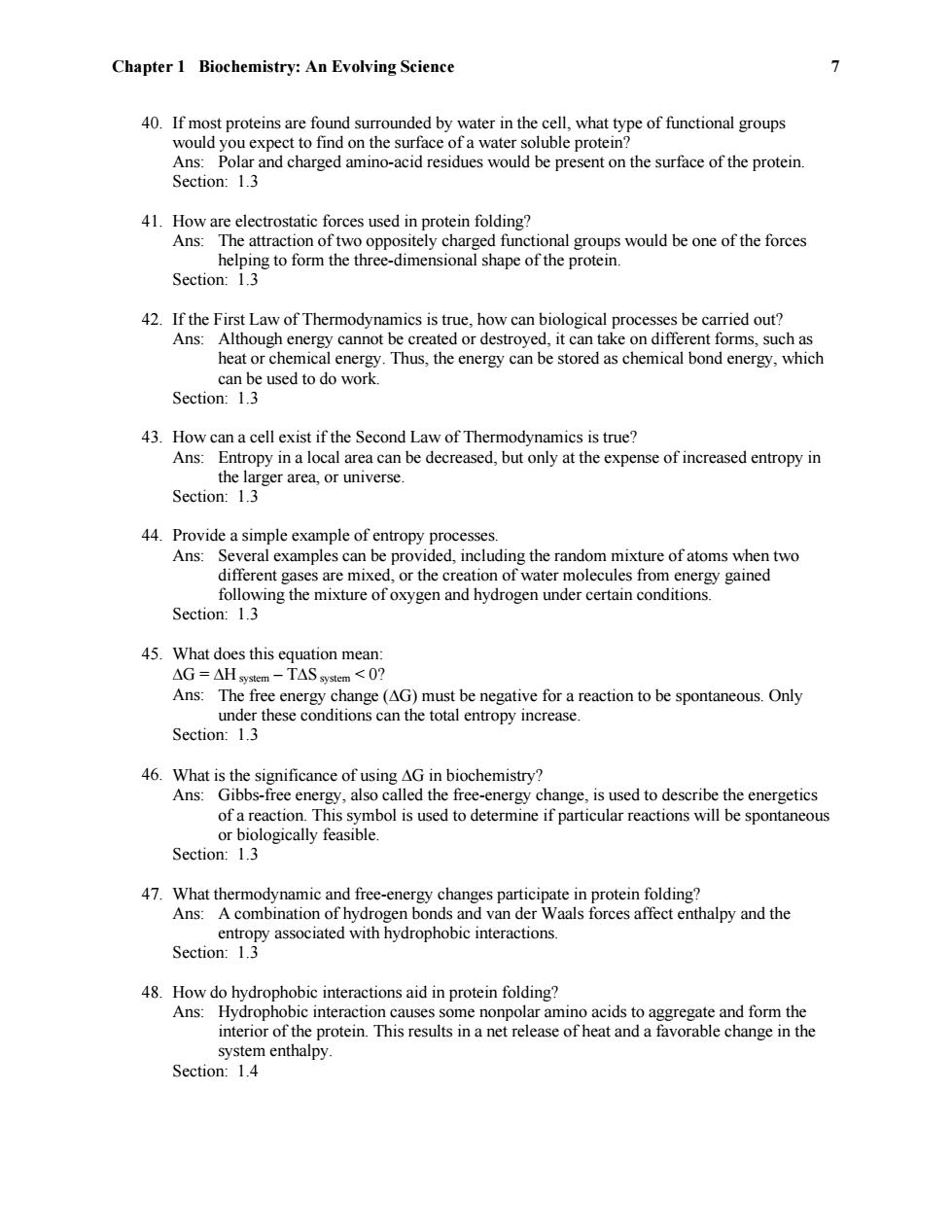正在加载图片...

Chapter 1 Biochemistry:An Evolving Science 7 40.If most proteins are found surrounded by water in the cell,what type of functional groups would you expect to find on the surface of a water soluble protein? Ans:Polar and charged amino-acid residues would be present on the surface of the protein. Section:1.3 41.How are electrostatic forces used in protein folding? Ans:The attraction of two oppositely charged functional groups would be one of the forces helping to form the three-dimensional shape of the protein. Section:1.3 42.If the First Law of Thermodynamics is true,how can biological processes be carried out? Ans:Although energy cannot be created or destroyed,it can take on different forms,such as heat or chemical energy.Thus,the energy can be stored as chemical bond energy,which can be used to do work. Section:1.3 43.How can a cell exist if the Second Law of Thermodynamics is true? Ans:Entropy in a local area can be decreased,but only at the expense of increased entropy in the larger area,or universe. Section:1.3 44.Provide a simple example of entropy processes. Ans:Several examples can be provided,including the random mixture of atoms when two different gases are mixed,or the creation of water molecules from energy gained following the mixture of oxygen and hydrogen under certain conditions. Section:1.3 45.What does this equation mean: AG=△I system-T△S system<0? Ans:The free energy change(AG)must be negative for a reaction to be spontaneous.Only under these conditions can the total entropy increase. Section:1.3 46.What is the significance of using AG in biochemistry? Ans:Gibbs-free energy,also called the free-energy change,is used to describe the energetics of a reaction.This symbol is used to determine if particular reactions will be spontaneous or biologically feasible. Section:1.3 47.What thermodynamic and free-energy changes participate in protein folding? Ans:A combination of hydrogen bonds and van der Waals forces affect enthalpy and the entropy associated with hydrophobic interactions. Section:1.3 48.How do hydrophobic interactions aid in protein folding? Ans:Hydrophobic interaction causes some nonpolar amino acids to aggregate and form the interior of the protein.This results in a net release of heat and a favorable change in the system enthalpy. Section:1.4Chapter 1 Biochemistry: An Evolving Science 7 40. If most proteins are found surrounded by water in the cell, what type of functional groups would you expect to find on the surface of a water soluble protein? Ans: Polar and charged amino-acid residues would be present on the surface of the protein. Section: 1.3 41. How are electrostatic forces used in protein folding? Ans: The attraction of two oppositely charged functional groups would be one of the forces helping to form the three-dimensional shape of the protein. Section: 1.3 42. If the First Law of Thermodynamics is true, how can biological processes be carried out? Ans: Although energy cannot be created or destroyed, it can take on different forms, such as heat or chemical energy. Thus, the energy can be stored as chemical bond energy, which can be used to do work. Section: 1.3 43. How can a cell exist if the Second Law of Thermodynamics is true? Ans: Entropy in a local area can be decreased, but only at the expense of increased entropy in the larger area, or universe. Section: 1.3 44. Provide a simple example of entropy processes. Ans: Several examples can be provided, including the random mixture of atoms when two different gases are mixed, or the creation of water molecules from energy gained following the mixture of oxygen and hydrogen under certain conditions. Section: 1.3 45. What does this equation mean: G = H system – TS system < 0? Ans: The free energy change (G) must be negative for a reaction to be spontaneous. Only under these conditions can the total entropy increase. Section: 1.3 46. What is the significance of using G in biochemistry? Ans: Gibbs-free energy, also called the free-energy change, is used to describe the energetics of a reaction. This symbol is used to determine if particular reactions will be spontaneous or biologically feasible. Section: 1.3 47. What thermodynamic and free-energy changes participate in protein folding? Ans: A combination of hydrogen bonds and van der Waals forces affect enthalpy and the entropy associated with hydrophobic interactions. Section: 1.3 48. How do hydrophobic interactions aid in protein folding? Ans: Hydrophobic interaction causes some nonpolar amino acids to aggregate and form the interior of the protein. This results in a net release of heat and a favorable change in the system enthalpy. Section: 1.4